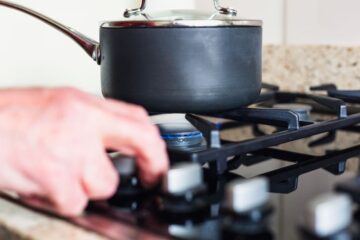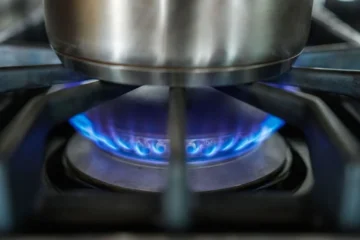Connecting a gas stove may seem like a daunting task, but with the right tools and knowledge, it can be a straightforward process. Gas stoves are a popular choice for cooking because they provide instant heat and precise temperature control. However, it is important to follow the correct steps to ensure that the stove is hooked up safely and correctly. In this article, we will provide a step-by-step guide on how to connect a gas stove, including tips and precautions to take along the way.
Before starting the installation process, it is important to gather all the necessary tools and equipment. This includes a wrench, pipe thread compound or gas-rated Teflon tape, a flexible gas line, and an adapter kit. It is also important to ensure that the gas supply is turned off before beginning any work. Once all the necessary tools and equipment are gathered, the installation process can begin.
The first step in connecting a gas stove is to locate the valve on the main gas pipe for the stove and ensure that it is in the off position. Once the valve is turned off, the flexible gas line can be connected to the stove using the adapter kit. From there, the line can be connected to the main gas pipe and secured using a wrench and pipe thread compound or gas-rated Teflon tape.
Safety Precautions
When connecting a gas stove, it is important to take safety precautions to prevent gas leaks and ensure proper ventilation. The following sub-sections outline important safety measures to take when connecting a gas stove.
Checking for Gas Leaks
Before connecting a gas stove, it is important to check for gas leaks. This can be done by spraying soapy water onto the gas line connections to the stove. If bubbles form, there is a gas leak and the connections should be tightened or replaced. It is also important to have a gas leak detector installed in the kitchen to detect any leaks that may occur.
Proper Ventilation
Proper ventilation is essential when using a gas stove to prevent the buildup of harmful gases such as carbon monoxide. It is recommended to run the exhaust fan above the range whenever the oven burners or stove is on, and keep it running for 20 minutes or so even after use. Additionally, it is important to ensure that the kitchen has adequate ventilation, such as a window or vent, to allow fresh air to circulate.
Shutting Off the Gas Supply
When connecting a gas stove, it is important to know how to shut off the gas supply in case of an emergency. The shut-off valve should be located near the gas meter and should be turned off if there is a gas leak or if the stove needs to be disconnected. It is also important to know how to relight the pilot light on the stove if it goes out, as this can be a safety hazard if not done correctly.
Preparing the Gas Stove
Before connecting a gas stove, it is important to prepare it properly. This section will outline the necessary steps to prepare a gas stove for connection.
Gathering the Necessary Tools
Before starting the preparation process, ensure that you have all the necessary tools. The following tools are required:
- Wrench
- Screwdriver
- Soapy water
- Cloth
Checking the Gas Connection
Before attaching the gas hose, it is important to check the gas connection on the stove. To do this, follow these steps:
1. Turn off the gas supply.
2. Remove the old hose, if present.
3. Check the gas connection for any damage or debris.
4. Clean the connection using a cloth.
5. Apply soapy water around the connection.
6. Turn on the gas supply.
7. Check for any bubbles forming around the connection.
8. If there are no bubbles, the connection is secure.
Attaching the Gas Hose
Once the gas connection has been checked and is secure, it is time to attach the gas hose. Follow these steps:
1. Turn off the gas supply.
2. Remove the old hose, if present.
3. Attach the new hose to the gas connection on the stove.
4. Use a wrench to tighten the connection.
5. Apply soapy water around the connection.
6. Turn on the gas supply.
7. Check for any bubbles forming around the connection.
8. If there are no bubbles, the connection is secure.
By following these steps, the gas stove will be properly prepared for connection.
Connecting the Gas Stove
Connecting a gas stove can seem intimidating, but with the right tools and knowledge, it can be done safely and easily. Here are the steps to connect a gas stove:
Aligning the Gas Connection
Before connecting the gas hose, ensure that the gas connection on the stove is properly aligned with the gas line. The gas connection should be located at the back of the stove, and it should be aligned with the gas line that comes out of the wall.
Attaching the Gas Hose
Once the gas connection is properly aligned, attach the gas hose to the stove. A flexible gas line is the best option, as it can easily bend to fit into tight spaces. Make sure the gas hose has the same size threading on the end as the regulator or it will not fit without an adaptor.
Tightening the Connections
After attaching the gas hose to the stove, use a wrench to tighten the connection. Make sure the connection is tight enough to prevent any gas leaks, but not so tight that it damages the gas line or the stove.
Next, attach the other end of the gas hose to the gas line coming out of the wall. Again, use a wrench to tighten the connection.
Finally, turn on the gas supply and check for any gas leaks. Use a gas leak detector or soapy water to check for any leaks. If you detect any leaks, turn off the gas supply immediately and tighten the connections again.
Testing the Gas Stove
When connecting a gas stove, it is important to test it before using it to ensure that it is safe and working properly. Testing the gas stove involves turning on the gas supply, checking for leaks, and testing the ignition system.
Turning on the Gas Supply
Before testing the gas stove, make sure that the gas supply is turned on. If the gas supply was turned off during installation, turn it back on and wait a few minutes for the gas to flow through the pipes.
Checking for Leaks
To check for leaks, mix a solution of equal parts water and dish soap in a spray bottle. Spray the solution on all the gas connections, including the flexible hose, gas valve, and burner valves. If you see bubbles forming, it means that there is a leak. Turn off the gas supply and tighten the connections. Then, spray the solution again to check for leaks.
Testing the Ignition System
To test the ignition system, turn on the stove and try to light each burner. If the burners light easily and produce a steady flame, the ignition system is working properly. If the burners do not light or produce an uneven flame, there may be a problem with the ignition system. In this case, turn off the stove and call a professional to inspect and repair the stove.
Conclusion
Connecting a gas stove is a task that requires a certain level of technical expertise and knowledge. It is not recommended for individuals who are not qualified gas engineers to attempt to connect a gas stove themselves.
When looking for a gas engineer, it is important to ensure that they are Gas Safe registered. This is a legal requirement in the UK. A Gas Safe registered engineer has the necessary training and qualifications to safely and legally connect a gas stove.
During the installation process, it is important to follow the manufacturer’s instructions carefully. This includes ensuring that the gas supply is turned off before beginning the installation and checking all connections for leaks once the installation is complete.
In addition, it is important to ensure that the gas stove is installed in a well-ventilated area and that all safety features, such as flame failure devices, are in place and functioning correctly.
Overall, connecting a gas stove is a task that should only be carried out by a qualified gas engineer. By following the manufacturer’s instructions carefully and ensuring that all safety features are in place, homeowners can enjoy the benefits of a gas stove in a safe and efficient manner.



